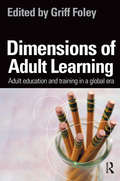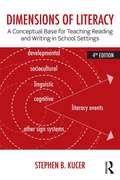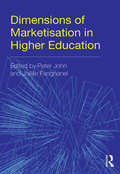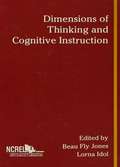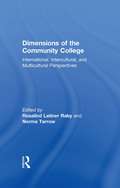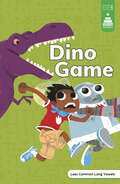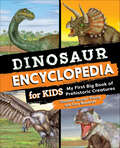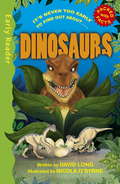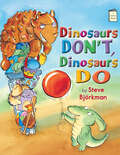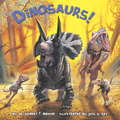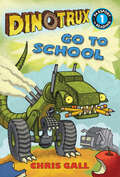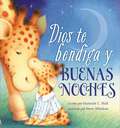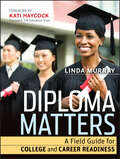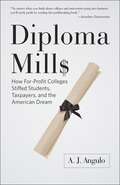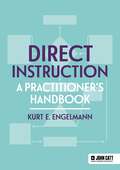- Table View
- List View
Dimensions of Adult Learning: Adult education and training in a global era
by Griff FoleyAdult education has never been more important or urgent than it is today Few educators have had the impact on adult education of Griff Foley. Professor Peter McLaren, University of California, Los Angeles This timely and valuable book makes an important contribution to our understanding of key recent developments in adult education and their significance. Reflecting the increasingly global nature of scholarship in the field, well-respected international contributors analyse issues facing practitioners today, and consider how these can be most positively embraced to further the international cause of adult learning and social justice. Janet Hannah, University of NottinghamLearning is central to all aspects of human life, and failure to learn brings dire consequences. As our world becomes more integrated and complex, adult learning has become more important. Dimensions of Adult Learning offers a broad overview of adult learning in the workplace and community. Written by a team of international experts, it introduces the core skills and knowledge which underpin effective practice. It examines adult education policy and research, and highlights the social nature of adult learning. It also examines adult learning in different contexts: on-line learning, problem-based learning, organisational and vocational learning. Dimensions of Adult Learning is an essential reference for professionals and students.Griff Foley is Research Associate in Adult Education at the University of Technology, Sydney. He is author of Learning in Social Action and Strategic Learning.
Dimensions of Literacy: A Conceptual Base for Teaching Reading and Writing in School Settings
by Stephen B. KucerThis popular text, now in its fourth edition, "unpacks" the various dimensions of literacy--linguistic and other sign systems; cognitive; sociocultural; and developmental--and at the same time accounts for the interrelationships among them. Distinguished by its examination of literacy from a multidimensional and interdisciplinary perspective, it provides a strong conceptual foundation upon which literacy curriculum and instruction in school settings can be grounded. Linking theory and research to practice in an understandable, user-friendly manner, the text provides in-depth coverage of the dimensions of literacy, includes demonstrations and "hands-on" activities, examines authentic reading and writing events that reflect key concepts, and summarizes the concepts in tables and figures. Changes in the Fourth Edition * Addresses academic language, new literacies/multiliteracies, and their relationship to literacy learning * More fully develops the developmental dimension of literacy in separate chapters on adult mediation and learner construction * Expands the discussion of multimodal literacies * Extends and integrates the discussion of bilingualism and biliteracy throughout the text * Integrates instructional implications more fully throughout
Dimensions of Literacy: A Conceptual Base for Teaching Reading and Writing in School Settings
by Stephen B. KucerThis popular text, now in its fourth edition, "unpacks" the various dimensions of literacy--linguistic and other sign systems; cognitive; sociocultural; and developmental--and at the same time accounts for the interrelationships among them. Distinguished by its examination of literacy from a multidimensional and interdisciplinary perspective, it provides a strong conceptual foundation upon which literacy curriculum and instruction in school settings can be grounded. Linking theory and research to practice in an understandable, user-friendly manner, the text provides in-depth coverage of the dimensions of literacy, includes demonstrations and "hands-on" activities, examines authentic reading and writing events that reflect key concepts, and summarizes the concepts in tables and figures. Changes in the Fourth Edition* Addresses academic language, new literacies/multiliteracies, and their relationship to literacy learning* More fully develops the developmental dimension of literacy in separate chapters on adult mediation and learner construction* Expands the discussion of multimodal literacies* Extends and integrates the discussion of bilingualism and biliteracy throughout the text* Integrates instructional implications more fully throughout
Dimensions of Marketisation in Higher Education
by Edited Peter John Joëlle FanghanelDimensions of Marketisation in Higher Education is a critical analysis of the various dimensions of marketisation in a global context, exploring governance, policy, financial, ethical and pedagogical aspects. Bringing together a selection of influential authors who draw on the work of Roger Brown, the book is a timely examination of the impact that policies regulating cost, entry and practices in higher education can have on universities, students and academics. This book explores the tensions and dilemmas marketisation brings into the educational environment for academic leaders, managers and students, arguing that they can be managed through rebalancing the relation between the market and the educational dimensions. Key topics include: The economics of higher education Students in a marketised environment Regulating a marketised sector Marketisation and higher education pedagogies Universities’ futures. Unveiling nuanced and multifaceted perspectives and providing readers with collective and forward-thinking critical analyses, Dimensions of Marketisation in Higher Education will be an authoritative reference book on policy and practice, appealing to higher education leaders, managers and scholars worldwide.
Dimensions of Teaching Business Ethics in Asia
by Parissa Haghirian Stephan RothlinA growing number of higher education institutions in Asia are now integrating ethics courses in their curricula. But the challenge remains to develop courses that can effectively reach their objectives, and to create and use teaching materials appropriate to the particular profile of the students and executives in different regions and cultures. In this context, enhancing awareness for ethical dilemmas, proposing frameworks and models to help managers handle difficult choices and demanding decisions - while not being moralistic and imposing values - , and presenting alternative approaches through recent and relevant cases are the main objectives of this book. It examines teaching methods, learning tools and pedagogical methods effective in the teaching of ethics within the particular context of the rich diversity of Asian cultures, and discusses ethics courses curricula, aiming at developing the capacity to deal with a number of issues such as corruption, intellectual property protection, whistle blowing and consumer rights. The relevance and limits of Asian philosophical and spiritual traditions and how their underlying values can be a meaningful aspect in the teaching of ethics to managers and business leaders are explored, as are the benefits and limits of corporate codes of conduct and ways to enhance their effectiveness. A similar approach is taken to the introduction of "oaths" and "ethics pledges" among business students, which has been promoted in some business schools.
Dimensions of Thinking and Cognitive Instruction
by Beau Fly Jones Lorna IdolBy establishing a conceptual framework and a common language for educators to work together, this volume attempts to answer the challenge facing all teachers -- how can students improve the quality of their thinking? Methods of strengthening the thought process include: helping students learn to monitor their attention and commitments; asking questions that require students to organize, analyze, and integrate information; setting tasks that involve complex processes such as problem solving and research; and modeling and reinforcing fair-mindedness.
Dimensions of the Community College: International, Intercultural, and Multicultural Perspectives (RoutledgeFalmer Studies in Higher Education #6)
by Rosalind Latiner Raby Norma TarrowProviding critical as well as pragmatic analysis, this volume examines the education programs that form an integral part of U. S. community colleges and their models abroad. The book's 15 original essays examine a variety of international and inter/multicultural education programs at selected North American community colleges and explore how the U. S. community college model is utilized in other nations. The book includes 11 tables/charts, three maps, four diagrams/figures and a subject index.
Dinaric Perspectives on PIRLS 2021: Prerequisites and Conditions for Teaching and Learning to Read (IEA Research for Education #17)
by Paulína Koršňáková Sabine Meinck Žaneta DžumhurThis open access book presents insights into the current state of reading literacy in the Dinaric region, namely the education systems in Albania, Croatia, Kosovo[1], Montenegro, North Macedonia, Serbia, and Slovenia. A collection of analyses reveals factors influencing this key capacity of young pupils. Using data from IEA&’s Progress in International Reading Literacy Study (PIRLS) 2021, the book explores teaching and learning reading literacy at the end of primary school (Grade 4) through multiple lenses, such as national reading curricula and textbooks, home and school resources for learning, student wellbeing, teacher education, instructions, and digital assessments. Since the administration of PIRLS 2021 coincided with the Covid-19 pandemic, the book also provides valuable insights into remote teaching and learning and other disruptions caused by the pandemic. This volume builds on the regional research presented in IEA Research for Education Volume 13, Dinaric Perspectives on TIMSS 2019, which explored the teaching and learning of mathematics and science in primary schools across the Dinaric region. Aimed at policymakers, researchers, and practitioners, Dinaric Perspectives on PIRLS 2021 offers multidimensional perspectives on student achievement in reading literacy in a region that is underrepresented in the English-speaking research literature on educational assessments and student performance. [1] This designation is without prejudice to positions on status and is in line with UNSCR 1244/1999 and the ICJ Opinion on the Kosovo declaration of independence.
Dinaric Perspectives on TIMSS 2019: Teaching and Learning Mathematics and Science in South-Eastern Europe (IEA Research for Education #13)
by Barbara Japelj Pavešić Paulína Koršňáková Sabine MeinckThis open access book brings together national experts from across the Dinaric region to rigorously review IEA’s Trends in International Mathematics and Science Study (TIMSS) 2019 grade four data to develop a multidimensional and culturally sensitive perspective on their TIMSS 2019 primary-level results. The Dinaric region, named after the Dinaric Alps, is located in South-eastern Europe, and stretches through Croatia, Bosnia and Herzegovina, Serbia, Montenegro, Kosovo[1], Albania, and North Macedonia. IEA’s TIMSS has been an invaluable resource for monitoring international trends in mathematics and science achievement at grades four and eight since 1995. The TIMSS 2019 administration of the test to grade four students, provided a unique opportunity for analysis within shared regional settings and enabled the construction of this first report based on international study results from the region, prepared by the National Research Coordinators in collaboration with IEA. [1] This designation is without prejudice to positions on status and is in line with UNSCR 1244/1999 and the ICJ Opinion on the Kosovo declaration of independence.
Dining with Jesus: A Seven Course Bible Study Unpacking the Key Meals Jesus Attended
by Kate JacksonThis seven-week guide aims to aid Christians, individually or in small groups, to take a closer look at seven of the meals Jesus attended, focusing on what Jesus was trying to communicate through them, either in the food eaten or in the social interactions he had whilst dining. Each session examines set bible passage(s), frequently considering them through the lens of the stories and teachings which bookend the meal. The sessions also prioritise posing questions to support Christians in reflecting upon their own lives and how they can further incorporate Jesus&’ teachings into them. This guide brings into one user-friendly volume a range of ideas that these meals explore, including God&’s grace, what real purity means, how Jesus equips us to further his Kingdom, the purpose of Jesus&’ miracles and the nature of Jesus&’ Messiahship, as well as current interpretations of these occasions of commensality and the relevance of their historical and social context, in a language that is easy to understand
Dino Game (Stairway Decodables Step 6)
by Leanna KochRory and Robot are going on a quest at the museum. Come along as they follow clues to explore the sights of the museum. There is so much to see and find in this exciting game! Stairway Decodables is a supplemental phonics resource that’s perfect for supporting small group instruction, independent reading, or reading practice at home. This title provides practice in decoding words with vowel combinations old, ild, olt, ind.
Dinosaur Dictionary for Kids: The Everything Guide for Kids Who Love Dinosaurs
by Bob KorpellaPacked with hundreds of illustrated definitions about dinosaurs and the world in which they lived, Dinosaur Dictionary for Kids is certain to spark any kid's enthusiasm for the age of dinosaurs. Explore the Mesozoic era. Learn about dinosaurs that lived on land, animals that swam the waters, and species that patrolled the skies. Find out about dinosaur extinction, how scientists date fossils, and what it takes to become a paleontologist. Dinosaur Dictionary for Kids will be there when it's time to write reports, delve into projects, prepare assignments, or just curl up and discover more about these amazing creatures. Sidebar topics, fun activities, and quick quizzes make learning about dinosaurs even more fun! Divided into sections for quick access to the easy-to-understand definitions and amazing full-color illustrations, Dinosaur Dictionary for Kids is a must-have for any kid's home library.Grades 3-6
Dinosaur Encyclopedia for Kids: My First Big Book of Prehistoric Creatures
by "Dinosaur George" Blasing Cary WoodruffDig up dino facts with this fun encyclopedia for kids ages 4 to 8 Dinosaurs are some of the most amazing animals that ever walked the Earth! They could be as tall as a four-story building or as small as a chicken. Some had spectacular spikes or hardened scales, while others had fantastic frills or vibrant feathers. This dinosaur book for kids gives them an exciting glimpse into the Age of Dinosaurs with awe-inspiring facts about how they lived, what they looked like, and more.This standout among dinosaur books for kids encourages them to:Discover dinos by era—Kids will learn about 90 different dinosaurs, organized by the prehistoric era in which they lived.Find kid-friendly facts—This dinosaur book helps kids expand their dino knowledge with bite-sized facts, a pronunciation guide, and a glossary with easy-to-understand definitions.Explore colorful illustrations—Inspire kids to travel back in time through detailed artwork that brings the dinosaurs to life.Get the best in dinosaur books for kids with this fun-filled dinosaur encyclopedia.
Dinosaurs (Early Reader Non Fiction)
by David LongEarly Readers are stepping stones from picture books to reading books. A green Early Reader is a first factbook.It's never too early to find out about... DINOSAURS. Did you know that the biggest dinosaurs weighed more than 13 or 14 elephants put together? Or that the EORAPTOR is the oldest dinosaur we know about and could run faster than an Olympic runner?Discover a world of incredible prehistoric reptiles in this brand new non fiction Early Reader from David Long, with full colour illustrations from Nicola O'Byrne on every page.
Dinosaurs (National Geographic Kids Readers)
by Kathleen ZoehfeldThere's nothing more fascinating than dinosaurs. In this Level 1 reader, youngsters learn all about the terrifying giants that once roamed the Earth—maybe even as close as their own backyard! They'll be wowed by new information and eye-popping illustrations from National Geographic, a trusted source of children's nonfiction content.National Geographic supports K-12 educators with ELA Common Core Resources.Visit www.natgeoed.org/commoncore for more information.
Dinosaurs Don't, Dinosaurs Do (I Like to Read)
by Steve BjörkmanHumorous Illustrations, easy-to-read text, and dinosaurs introduce young children to good manners and prosocial behavior. Dinosaurs don't just take, take, take; dinosaurs do share. When they are mad, they don't hit or bite; instead they use words to express their feelings. They shout and run outdoors; they don't shout at a wedding or run in the china shop. Illustrating this book with funny pictures of dinosaurs, Steve Björkman helps young children learn the benefits of being considerate toward others and the secret to making friends. An I Like to Read® book. Guided Reading Level E.
Dinosaurs! (Pictureback(R))
by Robert T. BakkerDinosaurs! follows the evolution of these spectacular creatures from their earliest beginnings as little fellows who had to evade attacks from giant croc relatives to today's living dinosaurs.
Dinosaurs: By The Numbers (By the Numbers)
by Steve JenkinsCaldecott Honor winner Steve Jenkins introduces By the Numbers infographic readers, chock full of incredible infographs and stunning, full color cut-paper illustrations. Dinosaurs will explore the world of these extinct giants, still living large in our imaginations today.Through infographics, illustrations, facts, and figures, readers will learn about the giants that roamed the earth millions of years ago, but that still captivate their imaginations: Dinosaurs. Discover some of the most fascinating aspects of dinosaurs through astonishing numbers: the varying sizes and shapes of dinosaurs, timelines of when they roamed the earth, charts comparing the fastest dinos with the speedy animals of today, maps of where these giant reptiles lived across the globe, and so much more. With his signature style, Steve Jenkins explores the most fascinating fields of natural science.
Dinotrux Go to School
by Chris GallDinotrux--the incredible dinosaur-truck mashups--are about to take the leveled reader category by storm! In this Passport to Reading Level 1 reader, today is the first day of school. The Dinotrux are nervous! What will they eat for lunch? Will their teacher be nice? But the Dinotrux don't need to worry. They can help each other. And school isn't scary. It's fun, especially when you are part dinosaur and part truck!
Dios El Espiritu Santo: Cuaderno De Trabajo Del Estudiante
by DR Pensacola H Jefferson¡DIOS SE ENLAZA y SE UNE A TI a través de “SU” ESPÍRITU SANTO MORADOR al igual que lo hizo con Jesús, la Palabra! "Yo y mi padre somos [no simplemente cercanos, sino]… UNO." (Juan 10:30 KJV). Jesús NO dijo que él y su padre estaban cerca, sino que era “UNO”. Estar cerca implica una cercanía, pero “uno” implica una sola unidad o un todo indiviso. En hebreo, la definición de unión (echadh) es “unidad”. Esta unidad es, ante todo, SANTA y única para Dios y Jesús (Deuteronomio 6:4). JESÚS es la PALABRA de DIOS. “… Él (Jesús) tenía un nombre escrito, que nadie conocía… su nombre era El Verbo de Dios…” (Apocalipsis 19: 12-13 NASB). La PALABRA de Dios Es ESPÍRITU. “…LAS PALABRAS QUE YO les hablo, SON ESPÍRITU…” (Juan 6:63 KJV) Así es, Jesús (LA PALABRA) es también ESPÍRITU. “…El señor es ESE ESPÍRITU…” (2 Corintios 3:17 KJV). Dios Es Espíritu. “…DIOS ES ESPÍRITU…” (Juan 4:24). Jesús (la palabra) es ESPÍRITU. “… El señor es ESE ESPÍRITU [¡TAMBIÉN!]…” (2 corintios 3:17 KJV). Dios es Espíritu y Jesús, la palabra es Espíritu. “… Yo y mi padre somos UNO…” (Juan 10:30 KJV). Los creyentes, ahora tienen el privilegio de decir, “… Yo y mi padre somos uno…, “TAMBIÉN”.
Dios te bendiga y buenas noches
by Hannah HallEste dulce libro se asegurará de que su pequeño se duerma sintiéndose seguro y amado.Las historias enDios te bendiga y buenas noches les recuerdan a lospequeños soñolientos de las bendiciones de Dios y lo amados que son. Estas encantadoras historias con rimas llevan a los lectores a través de varias escenas de animales arropaditos que se están preparando para la cama. Las dulces rimas, a veces bobas, y las adorables ilustraciones seguramente harán que este libro sea una parte favorita de la rutina de la hora de dormir para los padres y los niños.Dios te bendiga y buenas noches:Prepara a los niños para un sueño tranquilo y seguroLas frases que riman son divertidas para los pequeñitosEl dulce ritual antes de dormir fortalece los lazos entre padres e hijosIncluye hermosas ilustraciones que a los niños les encantaránGod Bless You and Good NightThis sweet book will make sure your little one falls to sleep feeling secure and loved.In God Bless You and Good Night, sleepy little ones are reminded of God&’s blessings and how much they are loved. The delightful rhyming story takes readers through several scenes of snuggly animals who are getting ready for bed. These sweet, sometimes silly rhymes and adorable art are sure to make God Bless You and Good Night a favorite part of the bedtime ritual for parents and children.God Bless You and Good Night:Prepares children for restful and secure sleepRhyming stories are fun for kidsSweet bedtime rituals strengthen bonds between parents and childrenFeatures delightful animal art kids will adore
Diploma Matters: A Field Guide for College and Career Readiness
by Linda MurrayIn our current education system too many high school students wind up with too few choices. Students are locked into what is decided for them by a broken system. Too often, they are handed a diploma that holds an empty promise. This practical field book is filled with effective tools from The Education Trust–West. Diploma Matters helps school leaders and teachers examine the current high school experience and develop a detailed action plan that will transform curriculum and ensure that all students are ready for college and the workplace.
Diploma Mills: How For-Profit Colleges Stiffed Students, Taxpayers, and the American Dream
by A. J. AnguloA provocative history of for-profit colleges and universities.Honorable Mention, PROSE Education Practice Award by the American Association of Publishers, FY17The most significant shift in higher education over the past two decades has been the emergence of for-profit colleges and universities. These online and storefront institutions lure students with promises of fast degrees and "guaranteed" job placement, but what they deliver is often something quite different. In this provocative history of for-profit higher education, historian and educational researcher A. J. Angulo tells the remarkable and often sordid story of these "diploma mills," which target low-income and nontraditional students while scooping up a disproportionate amount of federal student aid.Tapping into a little-known history with big implications, Angulo takes readers on a lively journey that begins with the apprenticeship system of colonial America and ends with today’s politically savvy $35 billion multinational for-profit industry. He traces the transformation of nineteenth-century reading and writing schools into "commercial" and "business" colleges, explores the early twentieth century’s move toward professionalization and progressivism, and explains why the GI Bill prompted a surge of new for-profit institutions. He also shows how well-founded concerns about profit-seeking in higher education have evolved over the centuries and argues that financial gaming and maneuvering by these institutions threatens to destabilize the entire federal student aid program.This is the first sweeping narrative history to explain why for-profits have mattered to students, taxpayers, lawmakers, and the many others who have viewed higher education as part of the American dream. Diploma Mills speaks to today’s concerns by shedding light on unmistakable conflicts of interest long associated with this scandal-plagued class of colleges and universities.
Diplomas and Diplomacy
by Aroop MukharjiThe first published work to chart the history of theMarshall Scholarship, this book details the origins of the Scholarship in theBritish Foreign Office and subsequently traces the award's evolution throughthe careers and narratives of a range of Scholars. It further explores thecomplex and dynamic interaction between education and diplomacy through thebroader lens of Anglo-American relations by way of extensive primary-sourcedocument research, interviews, and statistical analysis.
Direct Instruction: A practitioner's handbook
by Kurt EngelmannDirect Instruction (DI) is a powerful instructional approach designed to ensure that students master critical skills and content required for more advanced learning. Although DI has existed since the late 1960s, there are many common misconceptions about the approach, its potential to enhance student learning and the way its proper implementation facilitates students' academic success. This book provides a systematic explanation of the Direct Instruction methodology and DI program design as it outlines a roadmap for teachers and school leaders on how to implement DI successfully. Divided into three main sections, the first section describes DI as a coherent and complete teaching-and-learning system that contrasts DI with lower case "di" or explicit instruction, which focuses on effective instructional delivery techniques. The second section provides a step-by-step guide to implementing DI. The third section is devoted to cautions about implementing DI. This section reinforces the notion that the physical possession of the DI curricula does not by itself lead to student success. Those who adopt DI need to ensure that it is implemented with fidelity for the benefit of their students who are reliant on them to provide them with the means to achieve their academic potential so they may lead healthy, productive lives.
